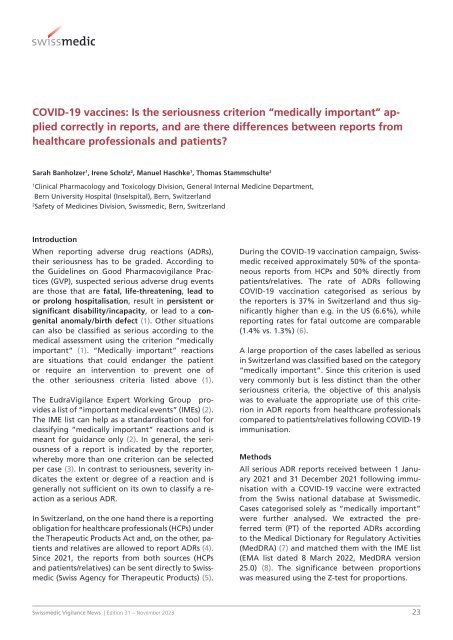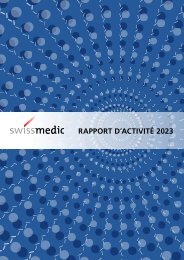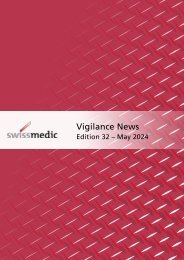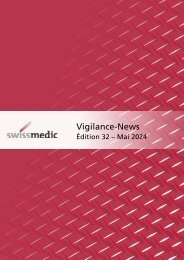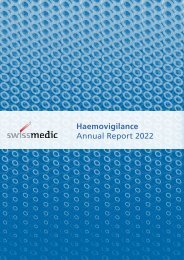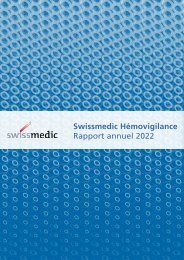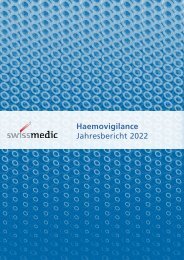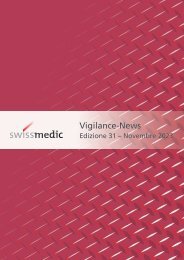Swissmedic Vigilance News
Edition 31 – November 2023
Edition 31 – November 2023
Create successful ePaper yourself
Turn your PDF publications into a flip-book with our unique Google optimized e-Paper software.
COVID-19 vaccines: Is the seriousness criterion “medically important” applied<br />
correctly in reports, and are there differences between reports from<br />
healthcare professionals and patients?<br />
Sarah Banholzer 1 , Irene Scholz 2 , Manuel Haschke 1 , Thomas Stammschulte 2<br />
1<br />
Clinical Pharmacology and Toxicology Division, General Internal Medicine Department,<br />
Bern University Hospital (Inselspital), Bern, Switzerland<br />
2<br />
Safety of Medicines Division, <strong>Swissmedic</strong>, Bern, Switzerland<br />
Introduction<br />
When reporting adverse drug reactions (ADRs),<br />
their seriousness has to be graded. According to<br />
the Guidelines on Good Pharmacovigilance Practices<br />
(GVP), suspected serious adverse drug events<br />
are those that are fatal, life-threatening, lead to<br />
or prolong hospitalisation, result in persistent or<br />
significant disability/incapacity, or lead to a congenital<br />
anomaly/birth defect (1). Other situations<br />
can also be classified as serious according to the<br />
medical assessment using the criterion “medically<br />
important” (1). “Medically important” reactions<br />
are situations that could endanger the patient<br />
or require an intervention to prevent one of<br />
the other seriousness criteria listed above (1).<br />
The Eudra<strong>Vigilance</strong> Expert Working Group provides<br />
a list of “important medical events” (IMEs) (2).<br />
The IME list can help as a standardisation tool for<br />
classifying “medically important” reactions and is<br />
meant for guidance only (2). In general, the seriousness<br />
of a report is indicated by the reporter,<br />
whereby more than one criterion can be selected<br />
per case (3). In contrast to seriousness, severity indicates<br />
the extent or degree of a reaction and is<br />
generally not sufficient on its own to classify a reaction<br />
as a serious ADR.<br />
In Switzerland, on the one hand there is a reporting<br />
obligation for healthcare professionals (HCPs) under<br />
the Therapeutic Products Act and, on the other, patients<br />
and relatives are allowed to report ADRs (4).<br />
Since 2021, the reports from both sources (HCPs<br />
and patients/relatives) can be sent directly to <strong>Swissmedic</strong><br />
(Swiss Agency for Therapeutic Products) (5).<br />
During the COVID-19 vaccination campaign, <strong>Swissmedic</strong><br />
received approximately 50% of the spontaneous<br />
reports from HCPs and 50% directly from<br />
patients/relatives. The rate of ADRs following<br />
COVID-19 vaccination categorised as serious by<br />
the reporters is 37% in Switzerland and thus significantly<br />
higher than e.g. in the US (6.6%), while<br />
reporting rates for fatal outcome are comparable<br />
(1.4% vs. 1.3%) (6).<br />
A large proportion of the cases labelled as serious<br />
in Switzerland was classified based on the category<br />
“medically important”. Since this criterion is used<br />
very commonly but is less distinct than the other<br />
seriousness criteria, the objective of this analysis<br />
was to evaluate the appropriate use of this criterion<br />
in ADR reports from healthcare professionals<br />
compared to patients/relatives following COVID-19<br />
immunisation.<br />
Methods<br />
All serious ADR reports received between 1 January<br />
2021 and 31 December 2021 following immunisation<br />
with a COVID-19 vaccine were extracted<br />
from the Swiss national database at <strong>Swissmedic</strong>.<br />
Cases categorised solely as “medically important”<br />
were further analysed. We extracted the preferred<br />
term (PT) of the reported ADRs according<br />
to the Medical Dictionary for Regulatory Activities<br />
(MedDRA) (7) and matched them with the IME list<br />
(EMA list dated 8 March 2022, MedDRA version<br />
25.0) (8). The significance between proportions<br />
was measured using the Z-test for proportions.<br />
<strong>Swissmedic</strong> <strong>Vigilance</strong> <strong>News</strong> | Edition 31 – November 2023<br />
23


